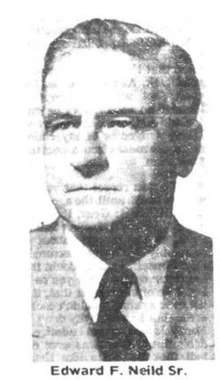Edward F. Neild
Edward Fairfax Neild, Sr. | |
|---|---|
 Neild circa 1950-1960 | |
| Born | December 3, 1884 |
| Died | July 6, 1955 (aged 70) |
| Resting place | Forest Park East Cemetery in Shreveport |
| Alma mater | Tulane University |
| Occupation(s) | Architect of Harry S. Truman Presidential Library and Museum and many public buildings in Louisiana |
| Spouse | Ethel Land Neild (married 1907-1955, his death) |
| Children | Edward F. Neild, Jr. Elizabeth "Betty" Neild Van Hook |
| Parent(s) | George Frederick and Elizabeth Moss Neild |

Edward Fairfax Neild, Sr. (December 3, 1884 – July 6, 1955), was an American architect originally from Shreveport, Louisiana, who designed the Harry S. Truman Presidential Library and Museum in Independence, Missouri. He was selected for the task by U.S. President Harry Truman.
Biography
The son of George Frederick Neild (1855-1933) and the former Elizabeth Moss, Neild graduated in 1906 from the School of Engineering at Tulane University in New Orleans. He then traveled in Europe to study architecture and applied arts. He worked alone from 1908 to 1934.[1] He was in partnerships Neild, Somdal and Neild, Somdal, Neild, with Dewey A. Somdal (1898-1973) and with his son, Edward Fairfax Nield, Jr.[2] (October 7, 1908 – November 8, 1958). Somdal Associates, Shreveport, is the descendant of the Neild firm.[3]
Neild served as president of the Shreveport chapter of the American Institute of Architects (AIA) in 1926 and from 1937 to 1939; Dewey Somdal was the president from 1940 to 1943; Edward F. Nield, Jr., in 1951.[4] In 1948, Neild was among twenty distinguished architects made fellows of the American Institute of Architects.[1]
During World War II, Neild designed for the United States Army Corps of Engineers the Japanese relocation centers in southeastern Arkansas at Rohwer and Jerome in Desha and Drew counties, respectively.[1]
Other Neild buildings include in Shreveport the Louisiana State Exhibit Building at the Louisiana State Fairgrounds and the Overton Brooks Veterans Administration Medical Center. When Truman toured Louisiana, he was so impressed with Neild's design of the Caddo Parish Courthouse that he contacted him to design the courthouse for his own Jackson County, Missouri. Neild was a consulting architect for the rehabilitation of the White House during the Truman years as well as the lead architect of the Truman Presidential Library. He also designed many campus buildings for Louisiana Tech University in Ruston.[1][5]
A number of Neild's works have been listed on the National Register of Historic Places as significant buildings for their architecture.[6]
In addition to their son, Neild and his wife, the former Ethel Land (1887-1970), who married on December 17, 1907, had a daughter,[1] Elizabeth "Betty" Neild Van Hook (1915-2010), the wife of the late James A. Van Hook.
Neild died in Kansas City, Missouri, at the age of seventy. The Neilds are interred at Forest Park Cemetery East in Shreveport.[7]
Works
Other Neild works include (with attribution):
- Arlington Ridge Park, NW corner of N. Meade St. and Marshall Dr. Arlington, Virginia (Neild, Edward F.), NRHP
- B'Nai Zion Temple, 802 Cotton St. Shreveport Neild, Edward F.), NRHP
- Baton Rouge Junior High School (built 1922), 1100 Laurel St. Baton Rouge Neild, Edward F.), NRHP
- Bogard Hall-Louisiana Tech University, Junction of Arizona and College St. Ruston, Louisiana Neild, Somdal & Neild), NRHP
- Bossier High School, 322 Colquitt St. Bossier City, LA Neild, Edward F.), NRHP
- Byrd, C. E., High School, 3201 Line Ave. Shreveport, LA Neild, Edward F.), NRHP
- Capital City Press Building, 340 Florida Baton Rouge, LA Neild, Edward F.), NRHP
- Fair Park High School, 3222 Greenwood Rd. Shreveport, LA Neild, Edward F.), NRHP
- Heidelberg Hotel, 201 Lafayette St. Baton Rouge, LA Neild, Edward F.), NRHP
- Heidelberg Hotel and Hotel King (boundary increase) 200 Lafayette St. Baton Rouge Neild, Edward F.), NRHP


- Howard Auditorium-Louisiana Tech University, Jct. of Adams Blvd. and Arizona St. Ruston Neild, Somdal & Neild), NRHP
- Keeny Hall-Louisiana Tech University, Keeny Circle Ruston, LA Neild, Somdal & Neild), NRHP
- One or more works in Lake Charles Historic District, Roughly bounded by Iris, Hodges, Lawrence, Kirkman, S. Divission and Louisiana Lake Charles, LA Neild, Edward F.), NRHP
- Maricopa County Courthouse, 125 W. Washington St. Phoenix, Arizona Neild, Edward F.), NRHP-listed
- Mooringsport School, 602 Latimer St. Mooringsport, Louisiana Neild, Edward F.), NRHP
- Prescott Memorial Library-Louisiana Tech University, Keeny Circle Ruston, LA Neild, Somdal & Neild), NRHP
- Rayville High School, 109 Madeline St., Rayville, Louisiana Neild, Edward F.), NRHP
- Reese Agriculture Building-Louisiana Tech University, Tech Farm, US 80 Ruston Neild, Somdal & Neild), NRHP
- Robinson Hall-Louisiana Tech University, Madison Ave. Ruston Neild, Somdal & Neild), NRHP
- Scott Street School, 900 N. 19th St. Baton Rouge Neild, Edward F.), NRHP
- Scottish Rite Cathedral, 725 Cotton St. Shreveport Neild, Edward F.), NRHP
- Shreveport Municipal Building, 724 McNeil St., Shreveport Neild, Edward F.), NRHP
- Steere, A. C., Elementary School, 4009 Youree Dr. Shreveport, LA Neild, Edward Fairfax), NRHP
- Toliver Dining Hall-Louisiana Tech University, Wisteria St. Ruston, LA Neild, Somdal & Neild), NRHP
- US Post Office and Courthouse-Alexandria, 515 Murray St. Alexandria, Louisiana Neild, Edward F.), NRHP
- Wray-Dickinson Building, 308 Market St., Shreveport Neild, Edward F.), NRHP
References
- ^ a b c d e "Neild, Edward F." lahisatory.org. Retrieved April 18, 2015.
- ^ DEWEY SOMDAL (1898-1973) COLLECTION, 1780-1972.
- ^ Mooringsport School Building
- ^ Past Presidents, AIA Shreveport
- ^ The Louisiana Historical Association used the Kansas City Star, July 6, 1955, and The New York Times and New Orleans Times-Picayune, both July 7, 1955, in its biographical sketch of Edward F. Neild.
- ^ "National Register Information System". National Register of Historic Places. National Park Service. July 9, 2010.
- ^ "Betty Neild Van Hook". findagrave.com. Retrieved April 18, 2015.
